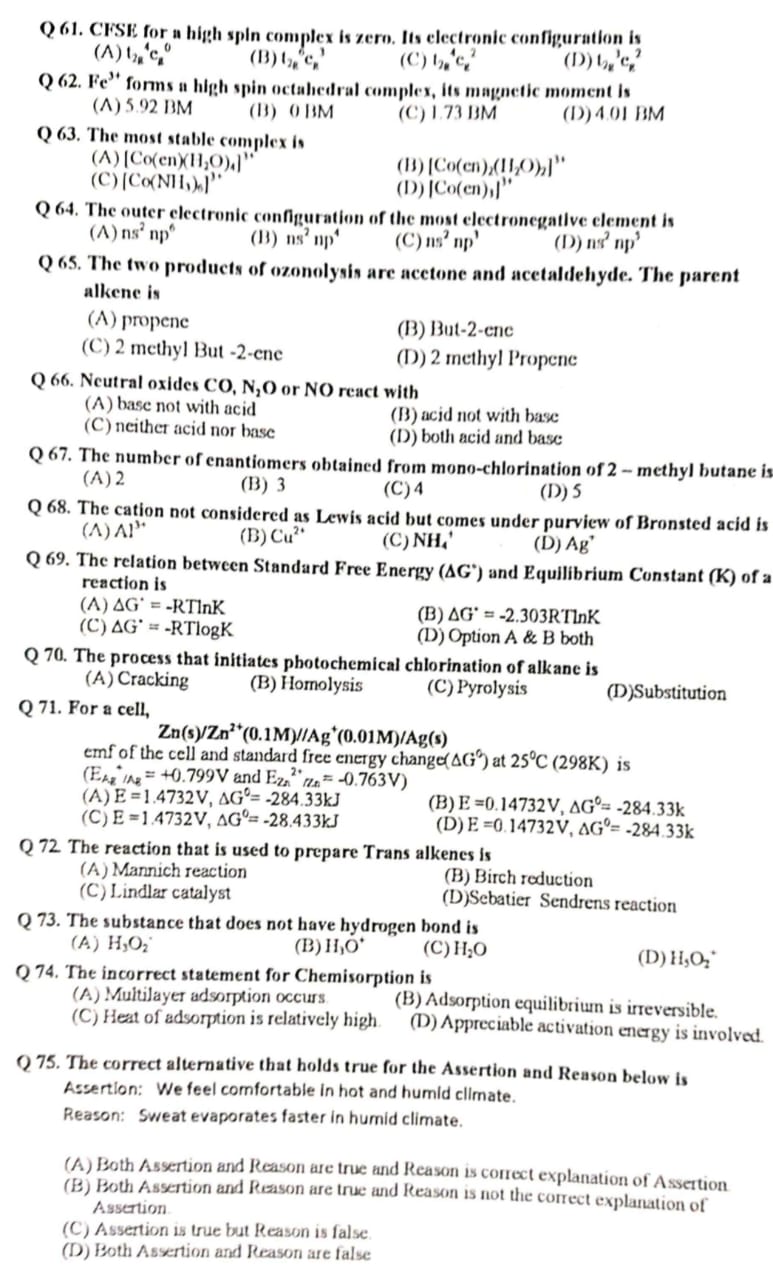Q61. CFSE for a high spin complex is zero. Its electronic configuration is? Q62. Fe3+ forms a high spin octahedral complex, its magnetic moment is? Q63. The most stable complex is?... Q61. CFSE for a high spin complex is zero. Its electronic configuration is? Q62. Fe3+ forms a high spin octahedral complex, its magnetic moment is? Q63. The most stable complex is? Q64. The outer electronic configuration of the most electronegative element is? Q65. The two products of ozonolysis are acetone and acetaldehyde. The parent alkene is? Q66. Neutral oxides CO, N2O or NO react with? Q67. The number of enantiomers obtained from mono-chlorination of 2-methyl butane is? Q68. The cation not considered as Lewis acid but comes under purview of Bronsted acid is? Q69. The relation between Standard Free Energy (AG°) and Equilibrium Constant (K) of a reaction is? Q70. The process that initiates photochemical chlorination of alkane is? Q71. For a cell, Zn(s)/Zn2+(0.1M)//Ag+(0.01M)/Ag(s) emf of the cell and standard free energy change(ΔG°) at 25°C (298K) is? Q72. The reaction that is used to prepare Trans alkenes is? Q73. The substance that does not have hydrogen bond is? Q74. The incorrect statement for Chemisorption is? Q75. The correct alternative that holds true for the Assertion and Reason below is: Assertion: We feel comfortable in hot and humid climate. Reason: Sweat evaporates faster in humid climate.

Understand the Problem
The question consists of multiple-choice questions covering various topics in chemistry, including complex ions, reactions, and thermodynamics. Each question asks for specific information or understanding of chemical principles.
Answer
61: \( t_{2g}^3e_g^2 \), 62: 5.92 BM, 63: \([Co(en)_3]^{3+}\), 64: \(ns^2np^5\), 65: 2-methyl but-2-ene, 66: acid not with base, 67: 2, 68: \(NH_4^+\), 69: \(ΔG^° = -RT\ln K\), 70: Homolysis, 71: \(E = 1.4732V, ΔG^° = -284.33 kJ\), 72: Lindlar catalyst, 73: \(H_3O_2^-\), 74: Multilayer adsorption occurs, 75: Both are false.
61: ( t_{2g}^3e_g^2 ), 62: 5.92 BM, 63: ([Co(en)_3]^{3+}), 64: (ns^2np^5), 65: 2-methyl but-2-ene, 66: acid not with base, 67: 2, 68: (NH_4^+), 69: (ΔG^° = -RT\ln K), 70: Homolysis, 71: (E = 1.4732V, ΔG^° = -284.33 kJ), 72: Lindlar catalyst, 73: (H_3O_2^-), 74: Multilayer adsorption occurs, 75: Both are false.
Answer for screen readers
61: ( t_{2g}^3e_g^2 ), 62: 5.92 BM, 63: ([Co(en)_3]^{3+}), 64: (ns^2np^5), 65: 2-methyl but-2-ene, 66: acid not with base, 67: 2, 68: (NH_4^+), 69: (ΔG^° = -RT\ln K), 70: Homolysis, 71: (E = 1.4732V, ΔG^° = -284.33 kJ), 72: Lindlar catalyst, 73: (H_3O_2^-), 74: Multilayer adsorption occurs, 75: Both are false.
More Information
Using crystal field theory and electronic configurations, these solutions provide insight into properties of transition metal complexes, reactions, and general chemistry principles.
Tips
For complex questions involving spin and electronic configurations, it's crucial to consider the type of ligands (strong or weak field) and the resulting arrangement of electrons in d-orbitals.
Sources
- High Spin and Low Spin Complexes - Chemistry LibreTexts - chem.libretexts.org
- Solved a) Two electronic configurations for an octahedral | Chegg.com - chegg.com
- For the octahedral complexes of Fe^{3+} in displaystyle ... - toppr.com
AI-generated content may contain errors. Please verify critical information